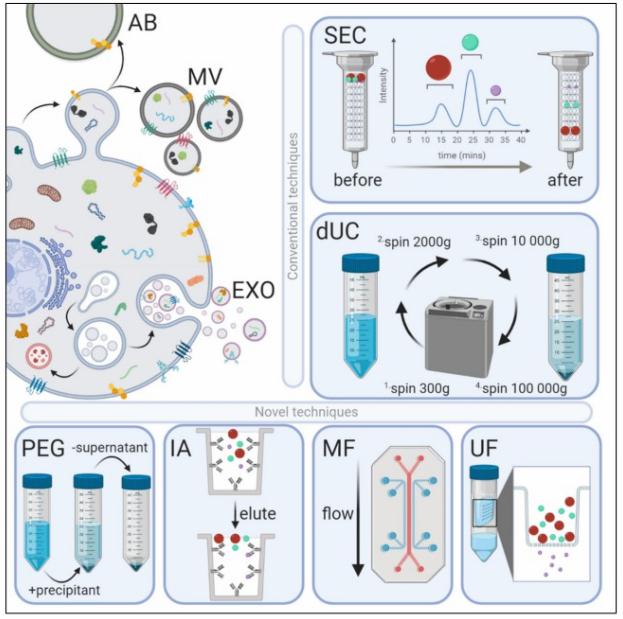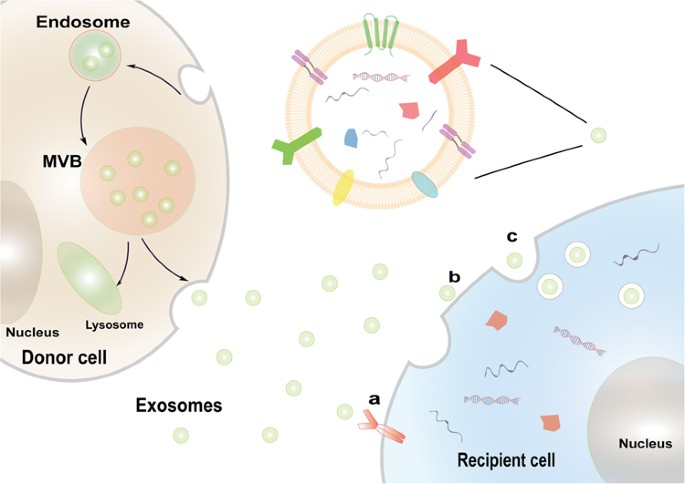Active Exosome Isolation Service

Exosomes are widely distributed in various body fluids and plants, protected by lipid bimolecular membranes with obvious advantages in abundance and stability. They are involved in various physiological and pathological processes and are a novel mechanism of intercellular communication, allowing cells to exchange proteins, lipids, and genetic material. Therefore, exosomes have gradually become potential carriers for nano-drug delivery or gene therapy. As natural carriers of functional small RNAs and proteins, exosomes have also attracted great interest in the field of drug delivery. The isolation and purification of naturally secreted exosomes have limited potential for direct use as drugs. However, the incorporation of components required for natural exosome secretion into synthetic liposomes or nanoparticles, And the engineered exosome mimetics assembled using a controllable program have more significant potential for pharmaceutical applications. Therefore, obtaining morphologically intact and biologically active exosomes becomes very important.

At present, the isolation of exosomes is mainly limited to gradient centrifugation. However, the exosomes obtained by this method are difficult to ensure their complete morphological characteristics and biological activities, thus limiting the application. Recently, researchers have developed an optimized exosome isolation technology, which uses a special material to separate and purify exosomes from plasma. The exosomes obtained by this method have completed morphological characteristics and maintain biological activity, which plays a vital role in using exosomes for drug delivery and exosome research. This method can not only obtain exosomes quickly but also has a very high-cost performance. These morphologically intact exosomes retain the role of mediating intercellular communication. Therefore, it shows excellent application potential in both drug delivery and immunotherapy.
The Advantages of this platform include:
- Simple and feasible
- Cost-effective
- The obtained exosomes are morphologically intact
- The obtained exosomes are biologically active
We can isolate active exosomes from the following samples:
- Tissue (adipose tissue, brain tissue, liver tissue, kidney tissue, muscle tissue, bone tissue, connective tissue, etc.)
- Body fluids (plasma, urine, saliva, cerebrospinal fluid, alveolar lavage fluid, amniotic fluid, follicular fluid, breast milk; feces, intestinal secretions, airway secretions, cervical secretions, sputum, semen, etc.)
- Cell culture supernatant (umbilical cord stem cells, placental tissue, neurons, red blood cells, tumor cells; lactobacillus, anaerobic bacteria, Schizochytrium sp., Dunaliella Salina, etc.)
Potential applications
- Exosome research
- Cancer treatment and immunotherapy
- Drug delivery system development, such as tablets, adjuvants, bandages, capsules, injections
- Cosmetic formulation development, such as moisturizer, powder, cream, lotion
- Health food formulation development, such as functional drinks, dietary supplements, formula milk
Creative Biostructure has been committed to the development and promotion of new exosome technologies. With our experienced team, we are more than happy to help with your research. Please do not hesitate to contact us for more details if you are interested in this new method, and we will provide considerate services for you.
Ordering process
References
- Yang E, et al. Exosome-mediated metabolic reprogramming: The emerging role in tumor microenvironment remodeling and its influence on cancer progression. Signal Transduction and Targeted Therapy. 2020. 5(1): 1-13.
- Sidhom K, et al. A review of exosomal isolation methods: is size exclusion chromatography the best option? International Journal of Molecular Sciences. 2020. 21(18): 6466.
